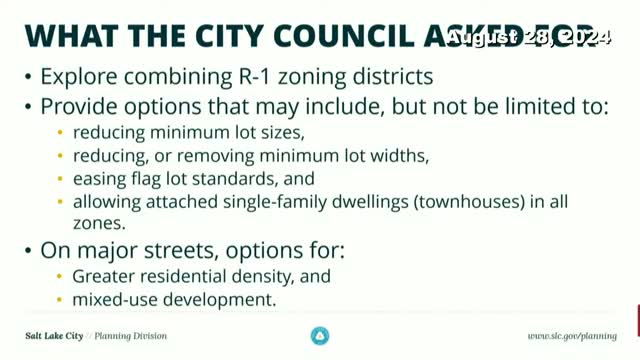City considers major zoning changes to boost housing supply
August 28, 2024 | Salt Lake City Council and RDA Board meetings, Salt Lake City, Salt Lake County, Utah
This article was created by AI summarizing key points discussed. AI makes mistakes, so for full details and context, please refer to the video of the full meeting. Please report any errors so we can fix them. Report an error »

In a recent government meeting, city officials discussed potential changes to the residential zoning code, specifically focusing on the consolidation of three existing R1 zones into a single zone. This initiative aims to facilitate the creation of more housing options by considering various strategies, including reducing minimum lot sizes and widths, easing regulations on flag lots, and permitting attached single-family dwellings, such as townhomes, across all zones.
The discussion highlighted the historical context of the R1 zoning, which dates back to the city's first zoning code adopted in 1927. Over the decades, the R1 zone has expanded, but many lots currently do not meet the minimum size requirements. Notably, more than a third of R1 lots in the city exceed the minimum lot size, indicating a potential for regulatory adjustments to better align with existing land use.
City officials emphasized that while consolidating the R1 zones could simplify the zoning code, it may not significantly increase housing availability due to existing lot size requirements. They presented a table evaluating various options for reducing lot sizes and widths, noting that more drastic changes could lead to increased housing production but might also raise community concerns.
The meeting also addressed the complexities surrounding flag lots, which are often hindered by stringent requirements that limit their development potential. Officials suggested that allowing lots without street frontage could enhance flexibility and potentially increase housing options.
Additionally, the council explored the possibility of permitting attached housing in R1 zones, which could provide more affordable housing alternatives. However, the current zoning landscape often pits residential developments against commercial interests, complicating the feasibility of such projects.
As the city moves forward, officials plan to refine their recommendations over the next two months, aiming to balance the need for attainable housing with the goal of simplifying the zoning code. The city council is expected to consider these recommendations and may initiate changes to the zoning regulations in response to the discussions held during the meeting.
The discussion highlighted the historical context of the R1 zoning, which dates back to the city's first zoning code adopted in 1927. Over the decades, the R1 zone has expanded, but many lots currently do not meet the minimum size requirements. Notably, more than a third of R1 lots in the city exceed the minimum lot size, indicating a potential for regulatory adjustments to better align with existing land use.
City officials emphasized that while consolidating the R1 zones could simplify the zoning code, it may not significantly increase housing availability due to existing lot size requirements. They presented a table evaluating various options for reducing lot sizes and widths, noting that more drastic changes could lead to increased housing production but might also raise community concerns.
The meeting also addressed the complexities surrounding flag lots, which are often hindered by stringent requirements that limit their development potential. Officials suggested that allowing lots without street frontage could enhance flexibility and potentially increase housing options.
Additionally, the council explored the possibility of permitting attached housing in R1 zones, which could provide more affordable housing alternatives. However, the current zoning landscape often pits residential developments against commercial interests, complicating the feasibility of such projects.
As the city moves forward, officials plan to refine their recommendations over the next two months, aiming to balance the need for attainable housing with the goal of simplifying the zoning code. The city council is expected to consider these recommendations and may initiate changes to the zoning regulations in response to the discussions held during the meeting.
View full meeting
This article is based on a recent meeting—watch the full video and explore the complete transcript for deeper insights into the discussion.
View full meeting

